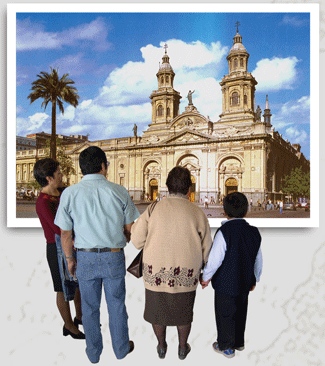Sociology

Peruvians in Chile: the challenge of intercultural education
Peruvians form nowadays the group of largest presence in Chile. This phenomenon has caused a rise in discrimination, xenophobia and racism among the Chilean population. Therein lays the importance of intercultural education in our society; it is as a mechanism to promote, from the schools, relationships of solidarity and democracy based on acceptance and mutual respect.
References
Thesis: "Intercultural Education: theories, politics and practices. Peruvian migration in today¿s Chile. New situations and challenges for integration". Author: Rolando Poblete Melis. Director: Silvia Carrasco.
During the 1990s, Chile has become a center of attraction for diverse migrant groups from Latin America, especially Peruvians who form the group of largest presence in the country. This phenomenon has caused a rise in discrimination, xenophobia and racism among the Chilean population. Therein lays the importance of intercultural education in our society; it is as a mechanism to promote, from the schools, relationships of solidarity and democracy based on acceptance and mutual respect.
This investigation centers on three areas of discussion related to one another: firstly, the theory of intercultural education, then, its approach in politics, and lastly, ethnography is presented describing both the subjects related to the presence of Peruvians in Chile, as the situation in two educational centers in Santiago that have Peruvian students.
In the first part there is a theoretical educational reflection with the justifications that give pertinence and meaning to intercultural education from the point of view of the school's reality. There is also a mention of the way in which anthropology has tackled educational subjects and a theoretical development of the discipline. In an attempt to define and limit this area, two fundamental aspects are analyzed: the first shows the importance of cultural conflict inside schools with students from different groups, then, and as a consequence, the problem of social inequality of those who belong to minority groups. Finally, this investigation deals with the ethical basis of intercultural education and its aims, as well as with the modifications and reforms needed to implement it in situations of diversity. There are three central topics: beliefs and attitudes of teachers and administrators; changes in the curriculum and school structure.
The second part analyzes the political dimension of intercultural education, that is to say, the precise ways in which to face the conflicts of changing daily life through norms, laws and regulations. The supposition is that educational reflection has a correlation in politics. That is why the subjects inherent to intercultural education are exposed here.
First, there is an attempt to define the role of intercultural education inside the framework of the national state, pointing out how it inserts inside its structure, defining the exercise of citizenship and the rights derives from that condition. Then, there is a brief recount of the development of intercultural education in Latin America from a political perspective, with, later on, a summarized description of the cases of Mexico, Bolivia and Chile, as examples of discourses of this situation in this part of the world.
Lastly, the third part (formally an investigation that includes fieldwork) is an attempt to recompile antecedents of the immigration phenomenon in Chile in three levels: first, as a study of the situation in the country, quantifying and describing the presence of Peruvians; then, the way in which society builds discourses that exclude them and how these are repeated in neighborhoods; and lastly, the way in which schools reproduce those discourses. The fieldwork is based on the hypothesis that if educational establishments with minority groups implement educational processes based on the recognition of diversity, their greater visibility and use as learning resource will make those students have a better insertion in the daily dynamics of the school and allow them to integrate from a sense of acceptance and mutual respect. In this way, the dynamics of relationships existing in society and the neighborhoods is interrupted.
Two schools were chosen in Santiago to get to know the educational processes of Peruvian students and the way in which schools produce customs that exclude them. To prove the hypothesis, the investigation was centered on only one of them, due to the fact that it actively promotes integration, generating an atmosphere of acceptance of diversity and respect for its Peruvian students.
The results of the fieldwork corroborate the initial supposition; however there are a series of factors –and on different levels- that have to be strengthened so as to obtain a more effective development of intercultural education in Chile. Among other things, the following is pointed out:
2. On a macro level:
- Develop initiatives to make diversity visible in our society (State, universities, NGOs, social groups, etc).
- Promote respect for differences with actions of positive affirmation.
- Give migrant population rights independently of their legal status and guarantee equal access to social services.
- Design social and political plans with an intercultural focus.
2. On the level of the school structure
- Augmenting intercultural educational programs in terms of quantity and quality.
- Promoting alliances and coordination between similar organisms so as to give an institutional character to the educational initiatives.
- Making changes in the schools structure so as to reach an effective decentralization.
- Forming teachers in at least three priority fields:
4. Representations
5. Management of curriculum
6. Development of teaching
4. In the schools:
- Promote a curriculum that applies to the particular conditions of the schools:
4. Using the social and cultural context as a source and resource of the learning process.
5. Include diverse points of view about the situations or facts of interest.
6. Make progressive modifications to the curriculum.
- Promote actions of positive affirmation inside the schools:
1. Generate strategies of integration to improve relationships.
2. Make diversity visible and give it space in the schools´ daily life
Rolando Poblete Melis
2024 Universitat Autònoma de Barcelona
B.11870-2012 ISSN: 2014-6388
